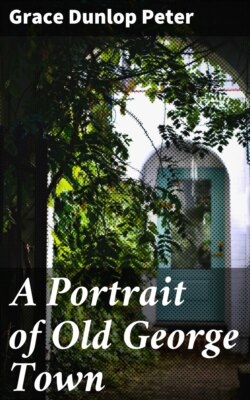Читать книгу A Portrait of Old George Town - Grace Dunlop Peter - Страница 13
На сайте Литреса книга снята с продажи.
The Streets of George Town and Some of the Happenings
ОглавлениеTable of Contents
THE houses had no numbers, but the streets had descriptive names. Along the river, Wapping, changing to The Keys and East to West Landing where all the busy loading and unloading of vessels took place. Just above there running west off Water Street for a short distance was Cherry Lane (now Grace Street). What a pretty name! Once a fashionable neighborhood, later on a slum.
Running north and south there was first Fishing Lane which became East Lane and finally settled down to Congress Street and is now Twenty-first.
Then the Main Street up from the ferry, called Water Street until it got to Bridge running east and west where was the Square, also called the Center of the Town. Then Water Street became High and Bridge continued on its way as the Falls Street—both names typical, as one was climbing a hill and the other was the road to The Little Falls. Duck Lane became Market (33rd) Street; Bridge (M) Street; Frederick (34th) Street, for it was the road out to Frederick Town, forty miles away; Potomac Street, for the river; Fayette Street, certainly named in honor of the Marquis, but in that age of young democracy, de la was dropped from de la Fayette. Then there was Montgomery (28th) Street, Greene (29th) Street, and Washington (30th) Street, all named for Generals of the Revolution. Running the other way were Gay, Dunbarton, Beall, West, Stoddert, this, for a long time was known as Back Street. West of High Street (Wisconsin Avenue) the streets became First, Second, Third, etc. Twenty-seventh Street, after being New Street for one block and Mill Street for another, finally was named for President Monroe. Madison had a street named for him too, but it was so far out, about 9th, in the far western corner, that it never amounted to much.
But the street that intrigues me most is Gay. There were two of them for a while, the one that is now N, and another, way up near the college, which was renamed in honor of General Lingan, after his tragic death. Who was Gay Street named for? It wasn't a local celebrity, for Baltimore also had a Gay Street, still has, way down in its old section. There was somebody the people of that generation admired and wished to commemorate.
Could it possibly have been the English poet, John Gay, (1685–1732) whose best known piece "The Beggar's Opera" was said to have made "The Rich gay and Gay rich"? He was buried in Westminster Abbey. His epitaph was by Alexander Pope, followed by Gay's own mocking couplet, "Life is a jest, and all things show it. I thought so once and now I know it."
The Beggar's Opera for a time drove Italian Opera off the English stage (1728) by its caricature of Sir Robert Walpole, Prime Minister of George II. These people were British subjects, you know, when these streets were named.
Somewhere in these quaint little streets in the early days before 1800, in one of these little brick houses, two stories with dormer windows, which the architects nowadays call the George Town Type, lived a couple named McDonald who had marital difficulties, for in an old newspaper is this advertisement:
